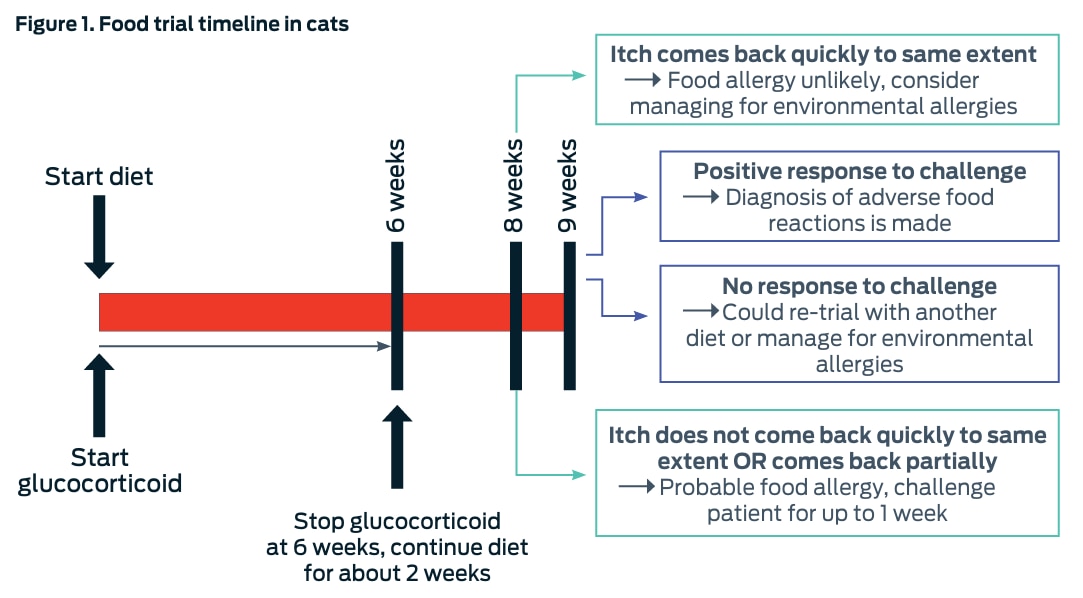
Dermatological Disorders & Gastrointestinal Disorders
Unique Characteristics of Food-Responsive Disease in Cats
Valerie A. Fadok
DVM, PhD, DACVD
Berthoud, Colorado, USA
Q. Why is food allergy difficult to diagnose in cats?
A. Food allergy cannot be easily differentiated from other causes of allergy, and we lack a diagnostic test. Furthermore, because true allergy can be difficult to differentiate from nonimmunologic food reactions, the tendency has been to use the term “adverse food reactions.” True food allergy exists, but not all cats produce IgE in response to food allergens; a cell-mediated response may be the mechanism. For this reason, a food trial followed by challenge, rather than a serum test, remains the best way to diagnose food allergy.1
Q. What are the most common clinical signs that allergic cats present with on the skin?
A. Cats with food allergy can present with 4 cutaneous reaction patterns:
- Overgrooming
- Miliary dermatitis
- Eosinophilic dermatitis (eosinophilic granuloma complex)
- Head and neck pruritus
Other signs associated with food-responsive disease in cats include gastrointestinal and respiratory diseases.
Q. When should we do a food trial, and how long should we feed the test diet during a food trial?
A. A food trial should be a consideration when cats have nonseasonal clinical signs that are associated with allergic skin disease. Many cats with nonseasonal disease may also be allergic to environmental allergens, but food allergens can be eliminated, reducing the need for medication to control clinical signs.
Eighty percent of cats with food allergy will have a response in 6 weeks; over 90% will respond in 8 weeks.2 Glucocorticoids can be used during the first 6 weeks of the trial (Figure 1) to help control clinical signs and improve compliance, but owners should be advised to monitor for side effects. The true diagnosis is made by challenging with the old diet or with single source proteins added to the diet sequentially. For cats with food allergy, a flare should be seen within 1 week.3 Many cat owners are reluctant to challenge once they see relief. Because the diets we use are complete and balanced, the owner may choose to continue the test diet indefinitely.

Q. What diet type should be selected for a food trial in cats?
A. Hydrolyzed protein diets are preferred for food trials. Novel protein diets have fallen out of favor, due to the potential for cross-reactivity among protein sources. If palatability is an issue in an individual cat, a novel protein may have to be selected to gain diet acceptance. If pet owners choose to home-cook a diet, consultation with a veterinary nutritionist is important to ensure the diet is complete and balanced.
Q. What problems are associated with cats and food trials?
A. Outdoor cats will find ways to supplement their diets. Unless the owner can have the cat live indoors for the duration of the trial, there is little value in doing a diet elimination trial. Multiple-cat households also are challenging. Unless the owner can feed the suspected food-allergic cat separately, they will need to feed all the cats the test diet during the trial. Even if they can feed one cat separately, the other cats’ food cannot be left down. Changing eating habits from free choice can be stressful for the whole household. Similar to dogs, treat, supplement, and flavored medication administration during the trial needs to be addressed with the pet owner.
Related Tools and Content:
Food Allergy and Food Intolerance
Food allergies and food intolerances are types of adverse food reactions.
Atopy (Atopic Dermatitis)
Nutrition can be incorporated in a multimodal approach to managing atopic dermatitis in pets.
Diet Elimination Trials
Diet elimination trials are the gold standard for the diagnosis of food allergies and food intolerances.
Applications for HYDROLYZED PROTEIN DIETS in Dermatologic and Gastrointestinal Diseases
Learn about adverse food reactions and how hydrolyzed protein diets can be used for the management of certain skin and gastrointestinal conditions.
How to Address a Client’s Misperceptions About Food Allergies
Watch Dr. Julie Churchill and Dr. Sarah Abood role-play a conversation in which a veterinarian addresses a client’s concern that her dog has a food allergy.
To Share With Pet Owner:
Feeding for Success: Tips for an Effective Food Elimination Trial
Share these tips with pet owners to help them understand what makes a food elimination trial successful.
References
- Jackson, H. A. (2023). Food allergy in dogs and cats; current perspectives on etiology, diagnosis, and management. Journal of the American Veterinary Medical Association, 261(S1), S23-S29. doi: 10.2460/javma.22.12.0548
- Olivry, T., Mueller, R. S., & Prelaud, P. (2015). Critically appraised topic on adverse food reactions of companion animals (1): Duration of elimination diets. BMC Veterinary Research, 11, 225. doi: 10.1186/s12917-015-0541-3
- Olivry, T., & Mueller, R. S. (2020). Critically appraised topic on adverse food reactions of companion animals (9): Time to flare of cutaneous signs after a dietary challenge in dogs and cats with food allergies. BMC Veterinary Research, 16(1), 158. doi: 10.1186/s12917-020-02379-3